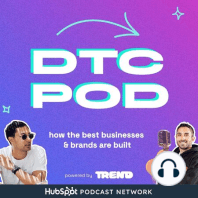7 min listen

How to grow a company to $50M+ in Miami (with Michael Martocci, CEO of Swagup)
How to grow a company to $50M+ in Miami (with Michael Martocci, CEO of Swagup)
ratings:
Length:
73 minutes
Released:
Jan 25, 2022
Format:
Podcast episode
Description
4:47 - When goals make senseGoals can be a waste of time at a young company. But once you grow, you need to figure out what to prioritize.I think to start off a company where you're at zero and come up with this master plan and all these OKRs and goals, I think it's just a huge waste of time. You should just spend more of that time talking to customers and figuring out building something that they need enough. Because if you don't have product-market fit, what's the point of goals? The point of goals for us was just, you have a lot of people. There's a lot of demand. How do we prioritize our time on the things that are most important? And how do you coordinate? Last year we had maybe seven director-above people, and now we have like 22. So if you have all those types of people leading different initiatives, how do you make sure that they know what's important at any given time? How are we measuring the success of that? How are the things that they're doing gonna impact other teams? What are the dependencies? If they say, Hey, we want to build X, Y, and Z. But if the engineering team doesn't have the people they need to do that, there's just so much more coordination as you get bigger. And without having clear goals, it's just really tough.9:57 - The forecasting breakthroughAs a bootstrapped business, SwagUp felt like it was starting each month as a blank slate. Michael took on the job of building a model that could accurately predict business.Every month, I would build out the model for that next month and the next quarter and stuff. And then I’d track like, what was the variance? What was the actual revenue? What did we end up doing? What is it looking like for the next few months? And it started to be very accurate. In the beginning it was like, plus or minus 20%, which was still really helpful. And then it started to get into like the plus or minus like 5%, 6%, 7%. So in the past we went from not knowing anything to now like, oh, we'll do $2.2 million next month. And then that was super helpful with the pandemic because when the world was kind of melting down, we weren't sure are people going to buy swag, or this or that? By like April and May, we saw enough early signals that would say, Hey, actually we're going to have our best month ever in this next month. So we just started to think much more from a machine standpoint, like, okay. What are all these inputs, and what's the output going to be? And that kind of changed my thinking around this stuff in general and try to find other areas of the business that have the same dynamic.13:32 - Pursuing a SaaS look & feelThere’s no doubt that SaaS tools are very intuitive to use. Michael wanted that same look and feel for SwagUp, so that tough tasks and decisions could become simple.I wanted it to feel like a SaaS tool. Because if you were like Twilio or Plaid or Stripe or any of these interesting software or platform-type companies, the people at those companies who are buying swag, they're going to these websites that feel very 2000s, very 1990s. And I was like, I want them to feel the same buying experience that they would feel buying some piece of software that they're using, and have a brand and positioning and design that resonates. So design was super, super important to me from the very beginning. Because one, it gives you credibility, and it tells you right away like, Hey, they take pride in what they're doing. It looks really legit. They've probably been around for a while. And we had to appear bigger than we were, but also wanted it to feel natural to them. Like, oh, if we're going to buy swag, this would be the type of company we would buy it from. So we've always been thinking about how do you productize the experiences as well, and make it really, really simple and eliminate decision fatigue…and it became like this mouse trap for us, where we were able to acquire so many customers because we just do this one thing very specifically.17:18 - The benefit of swagSwag is
Released:
Jan 25, 2022
Format:
Podcast episode
Titles in the series (100)
How to Grow Your Brand Without Facbeook Ads: In this episode, Ramon discusses how brands can still grow without ads, and why it’s important to be not fully reliant on them. Social ads have become a powerful tool to grow brands. Ramon will discuss how you can position yourself as a brand leader and create a brand that consumers keep on coming back to, not just because of Facebook ads. by DTC POD: How The Best Brands Are Built